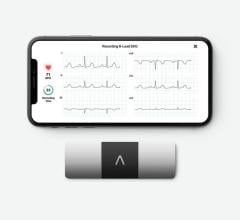
St. Jude Medicals Confirm ICM is used for patients with syncopes that are hard to detect. It can be used for up to three years to automatically record symptoms.
In a world where everything is unplugged and cordless is king, cardiology is constantly searching for and developing the technology to make patient care both better and more convenient.
Implantable cardiac monitors (ICMs) are the latest technology on the medical market to satisfy both those qualifications. Invasive and longer lasting than their predecessors, the Holter and loop event monitors, give patients freedom and doctors remote access to syncopal information. This combination results in better diagnosis of cardiac conditions like syncope, atrial fibrillation and other irregularities.
“Before we had this technology, we relied on event monitors that could only function for a max of 30 days,” said Jaymie Hitchcock, director of heart rhythm management department, Mid-America Cardiology, Kansas City, Kan. and Mo. The practice group uses St. Jude Medical’s Confirm ICM, FDA-approved in late 2008. “For patients with syncopes every six months, that’s hard. With this, though, it’s a simple procedure — easy to implant — it can be used up to three years, and it’s automatically recording the symptoms.”
Hitchcock, whose clinic sees a range of patients, said ICMs are not for everyone. Holter monitors, which examine every heartbeat for 24-48 hours, and event loop monitors, which function for 30 days, are tried-and-true recorders for patients with frequent or dependable symptoms.
For patients with rare syncope or presyncopal episodes, however, ICMs are revolutionizing diagnosis and understanding. Blair Grubb, M.D., director of cardiac electrophysiology service, University of Toledo School of Medicine, Toledo, Ohio, sees nothing but those patients in his syncope clinic. For his practice, the development of ICMs has been invaluable. Grubb uses the Medtronic Reveal XT, commercially available since February 2009.
“Previously when doing evaluations, it used to be a leap of faith,” he said. “Now, we can see real-world events as they occur. Now, we see that things are much different than we thought they were. We didn’t fully understand or have a grasp on how [syncopes and other cardiac irregularities] were occurring.”
Syncope can be infrequent, intermittent and seemingly unexplainable. Possible causes include exercise, arrhythmias and other cardiac conditions, and while syncope’s origins are wide-ranging, at least 10 percent of syncope patients’ causes remain unidentified (1). But by evaluating heart rhythm signals over long periods of time, ICMs like the Reveal XT and the Confirm are able to better illuminate the problems to allow doctors to give a more accurate diagnosis.
An Advance Over Holter Technology
Insertable cardiac monitors are meant for different patients, as opposed to their long-established heart-monitoring alternatives. They not only have a longer lifespan, they also utilize different technology. Holter monitors are portable devices connected to the body with electrodes that record electrical signals from the heart. The signals transfer to logging equipment, which attaches to a belt loop or a necklace. ICMs, on the other hand, are approximately the size of a thumb drive, are implanted subcutaneously and require no external wires or patches. Grubb said his experience with ICMs is not only that they work, but also that they’ve gotten better.
“The initial [models] were fairly primitive, but so were cell phones,” he says. “Initially, these had to be patient-activated, but now they record automatically.”
Patient ECGs Available 24/7
Medtronic CareLink Network reads the Reveal XT’s data from a monitor connected to a phone line, which then dials a preprogrammed number to send the information to a Medtronic website. After that, the information is available remotely via the Internet by the physician — at any time and without an appointment. Not only does this make information more accessible, but Grubb said it also gives peace of mind to those fitted with the ICM. “Patients feel reassured to be able to be monitored anywhere in the country,” he said. “It’s like being monitored 24/7 for three years.”
Hitchcock has also seen the benefits of ICMs’ remote capabilities. Confirm monitors connect to the St. Jude Merlin @home Transmitter, which similarly receives information, connects to a phone line and then transfers the data to a website. Remote followups are scheduled daily, often when a patient sleeps. Mid-America Cardiology, which has locations across eastern Kansas and western Missouri, can now consult patients that live five to six hours away. “Having the convenience to ask the patient to send the information from their bedroom and troubleshoot and figure out what’s been going on has made a huge difference,” she said.
Ruling out a heart rhythm irregularity or tracking it is, according to Hitchcock, one of the technology’s greatest strengths. Specialists who deal with syncopal patients, such as Grubb and Hitchcock, are now able, with the help of technology, to better determine the root of the problem.
“The goal of Norman Holter [the inventor of Holter monitors] was to be able to record and differentiate phantom arrhythmias. That was in 1964, and there were always people who were told they were crazy,” Grubb said. “Today, it’s amazing to see events as they actually happen — not as you project them to be and not as you think they are, but as they really are.”
Cost vs. Benefits
Patients suffering from heart irregularities are not likely to see only physical benefits of this technology. Although he cited occasional reimbursement issues, Grubb points to the 2002 randomized assessment syncope trial (RAST) study to show that a prolonged monitoring strategy is more cost-effective than conventional testing in patients with unexplained syncope. And because patients using a monitor like the Confirm or Reveal XT often suffer from rare syncopal events, Hitchcock points out that the one-time cost of inserting a more costly monitor generally outweighs the more-frequent cost of a Holter or loop event monitor.
References:
1. Kanjwal, Khalil et al. “Psychogenic Syncope? A Cautionary Note.” Pacing and Clinical Electrophysiology, July 2009, vol. 32, issue 7, pages 862–865.




 November 21, 2023
November 21, 2023 








